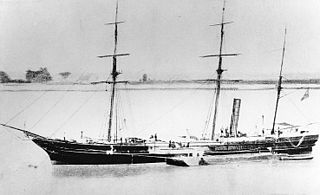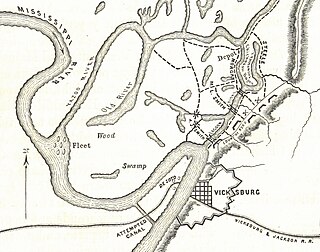
Ascension Parish is a parish located in the U.S. state of Louisiana. As of the 2020 census, the population was 126,500. Its parish seat is Donaldsonville. The parish was created in 1807. Ascension Parish is part of the Baton Rouge metropolitan statistical area.

Donaldsonville is a city in, and the parish seat of Ascension Parish in the U.S. state of Louisiana. Located along the River Road of the west bank of the Mississippi River, it is a part of the Baton Rouge metropolitan statistical area. At the 2020 U.S. census, it had a population of 6,695, down from 7,436 in 2010.

USS Brooklyn was a sloop-of-war authorized by the U.S. Congress and commissioned in 1859. Brooklyn was active in Caribbean operations until the start of the American Civil War at which time she became an active participant in the Union blockade of the Confederate States of America.

The siege of Port Hudson, Louisiana, was the final engagement in the Union campaign to recapture the Mississippi River in the American Civil War.

CSS McRae was a Confederate gunboat that saw service during the American Civil War. Displacing around 680 tons, she was armed with one 9-inch (229 mm) smoothbore and six 32-pounder (15 kg) smoothbore cannon.

USS Katahdin was a Unadilla-class gunboat built for the U.S. Navy during the American Civil War.

The First Battle of Memphis was a naval battle fought on the Mississippi River immediately North of the city of Memphis, Tennessee on June 6, 1862, during the American Civil War. The engagement was witnessed by many of the citizens of Memphis. It resulted in a crushing defeat for the Confederate forces, and marked the virtual eradication of a Confederate naval presence on the river. Despite the lopsided outcome, the Union Army failed to grasp its strategic significance. Its primary historical importance is that it was the last time civilians with no prior military experience were permitted to command ships in combat. As such, it is a milestone in the development of professionalism in the United States Navy.

USS Sciota was a Unadilla-class gunboat built on behalf of the United States Navy for service during the Civil War. She was outfitted as a gunboat, with both a 20-pounder rifle for horizontal firing, and two howitzers for shore bombardment, and assigned to the Union blockade of the waterways of the Confederate States of America.

Grant's Canal was an incomplete military effort to construct a canal through De Soto Point in Louisiana, across the Mississippi River from Vicksburg, Mississippi. During the American Civil War, United States Navy forces attempted to capture the Confederate-held city of Vicksburg in 1862, but were unable to do so with army support. Union Brigadier General Thomas Williams was sent to De Soto Point with 3,200 men to dig a canal capable of bypassing the strong defenses around Vicksburg. Despite help from local plantation slaves, disease and falling river levels prevented Williams from successfully constructing the canal, and the project was abandoned until January 1863, when Union Major General Ulysses S. Grant took an interest in the project.

The capture of New Orleans during the American Civil War was a turning point in the war, which precipitated the capture of the Mississippi River. Having fought past Forts Jackson and St. Philip, the Union was unopposed in its capture of the city itself.

The Battle of Forts Jackson and St. Philip was the decisive battle for possession of New Orleans in the American Civil War. The two Confederate forts on the Mississippi River south of the city were attacked by a Union Navy fleet. As long as the forts could keep the Federal forces from moving on the city, it was safe, but if they fell or were bypassed, there were no fall-back positions to impede the Union advance.
River Road African American Museum is a museum of culture and history in Donaldsonville, Louisiana, United States. Founded in 1994, it was among the first Louisiana museums to tell the story of Africans and African Americans, both slave and free. The museum notes their contributions to the River Road region, both before and after the American Civil War. Because of its significance, the museum was identified as one of the first 26 sites included by the state in 2008 on the Louisiana African American Heritage Trail.

The Battle of Baton Rouge was a ground and naval battle in the American Civil War fought in East Baton Rouge Parish, Louisiana, on August 5, 1862. The Union victory halted Confederate attempts to recapture the capital city of Louisiana.

New Orleans, Louisiana, was the largest city in the South, providing military supplies and thousands of troops for the Confederate States Army. Its location near the mouth of the Mississippi made it a prime target for the Union, both for controlling the huge waterway and crippling the Confederacy’s vital cotton exports.
The Battle of LaFourche Crossing was a battle in Lafourche Parish, Louisiana, United States and fought on June 20–21, 1863, during the American Civil War as part of a campaign known as Taylor's Operations in West Louisiana.

The Battle of Kock’s Plantation was a battle fought July 12–13, 1863, in Ascension Parish, Louisiana, during the American Civil War. It was part of a campaign entitled "Taylor's Operations in West Louisiana (1863)." The Confederate States Army victory left them in control of much of the interior of the Acadiana region.
The Second Battle of Donaldsonville was an American Civil War battle took place on June 28, 1863 in Ascension Parish, Louisiana.

USS Winona was a Unadilla-class gunboat built for service with the Union Navy during the American Civil War. Winona was heavily armed, with large guns for duels at sea, and 24-pounder howitzers for shore bombardment. Winona saw significant action in the Gulf of Mexico and in the waterways of the Mississippi River and was fortunate to return home safely after the war for decommissioning.

The 2nd Louisiana Cavalry Regiment was a unit of mounted volunteers recruited in Louisiana that fought in the Confederate States Army during the American Civil War. Breazeale's Cavalry Battalion was formed in July 1862 and was augmented by five additional companies in September 1862 to form a regiment. It served for the entire war west of the Mississippi River in the Trans-Mississippi Department. The regiment fought at Georgia Landing, Fort Bisland, Irish Bend, and Brashear City in 1863 and Henderson's Hill and Mansfield in 1864. Afterward, the regiment fought in minor skirmishes before the Trans-Mississippi's final surrender on 26 May 1865.

The Donaldsonville Louisiana Artillery was a Louisiana artillery unit that fought in the Confederate States Army during the American Civil War. Formed from an old militia company, it arrived in the Eastern Theater of the American Civil War in September 1861 with three obsolete guns and was equipped with three additional rifled guns. The battery fought at Yorktown, Williamsburg, Seven Pines, Gaines' Mill, Glendale, Second Bull Run, Antietam, Shepherdstown and Fredericksburg in 1862. The following year the unit served at Gettysburg and in the Bristoe and Mine Run campaigns. The battery fought in the Overland campaign and at the Siege of Petersburg in 1864. It surrendered at Appomattox in April 1865.















